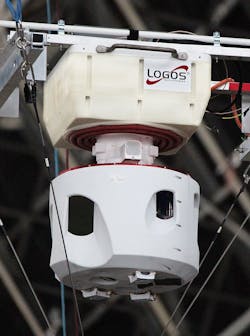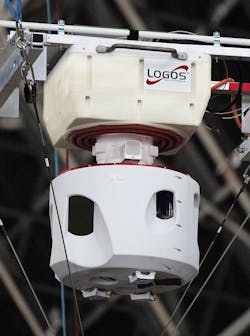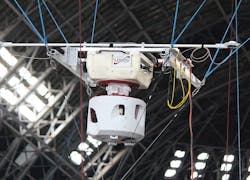Logos Technologies unveils lightweight Kestrel wide-area camera system for aerostats
FAIRFAX, Va., 21 Sept. 2016. Logos Technologies engineers have designed and developed a new, lightweight, day/night, wide-area motion imagery (WAMI) sensor based on the company’s battle-proven Kestrel system. The Kestrel KS-200, an 80-pound version of the original Kestrel system that has been deployed on aerostats with U.S. forces in Iraq and Afghanistan since 2011, will make its public debut at the Association of the United States Army (AUSA) annual meeting and exposition next month in Washington.
The new lightweight WAMI system is compatible with small aerostats; on larger aerostats, it can be paired with a wider range of sensors and communications equipment without overtaxing the aerial platform. The Kestrel KS-200, for example, can be flown with twin full-motion video cameras on the U.S. Army’s Persistent Threat Detection System aerostats, officials say.
The new KS-200 further differentiates itself from the original Kestrel by being widely exportable. “With the KS-200, international customers now have the same capabilities as the original Kestrel sensor,” Marion adds.
The KS-200 is the second aerostat-mounted WAMI sensor developed by Logos Technologies for export. The first such system was the 40-pound, day-only Simera, which was operated by the Brazilian authorities during the recent Olympics games. (Read about that contract and applicationhere: http://www.intelligent-aerospace.com/articles/2016/09/hpec-enables-onboard-data-processing-for-persistent-surveillance.html.)
Both Kestrel KS-200 and Simera will be showcased at the Logos Technologies booth at the AUSA expo.
In addition, the company will have the Redkite RK-50 WAMI sensor on display. Designed for planes, helicopters, and unmanned aerial vehicles, the day-only Redkite pod comes in at under 30 pounds and can be configured to weigh even less than that.
Logos Technologies will be in Booth 253 at the Walter E. Washington Convention Center during AUSA.
Founded in 1996, Logos Technologies LLC is a diversified science, engineering, and technology company specializing in the fields of advanced sensors, wide-area motion imagery, advanced analytics, and processing of large, multisource datasets. Logos serves government customers, including the Department of Defense, Intelligence Community, and Department of Homeland Security, as well as a range of customers in commercial and international markets.
Search the Aerospace & Defense Buyer's Guide
You might also like:
Subscribe today to receive all the latest aerospace technology and engineering news, delivered directly to your e-mail inbox twice a week (Tuesdays and Thursdays). Sign upfor your free subscription to the Intelligent Inbox e-newsletter at http://www.intelligent-aerospace.com/subscribe.html.
Connect with Intelligent Aerospace on social media: Twitter (@IntelligentAero), LinkedIn,Google+, and Instagram.
Intelligent Aerospace
Global Aerospace Technology NetworkIntelligent Aerospace, the global aerospace technology network, reports on the latest tools, technologies, and trends of vital importance to aerospace professionals involved in air traffic control, airport operations, satellites and space, and commercial and military avionics on fixed-wing, rotor-wing, and unmanned aircraft throughout the world.



